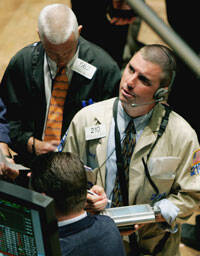The R Word
Regulation. The word you thought would never cross Republican lips has been uttered by a cabinet-level official. Treasury Secretary Henry M. Paulson Jr. announced March 26 that it is time for “us all to think more broadly about the regulatory and supervisory framework” for financial institutions. Since the Great Depression, the federal government has regulated commercial banks, overseeing their transactions, limiting their activities and establishing reserve requirements. Until now, it has not regulated other financial institutions. Following the Federal Reserve Bank’s recent agreement to back up the purchase of Bear Stearns with a $30 billion guarantee, fear of a massive financial collapse has forced the administration to propose a comprehensive program to revamp the government’s role in financial markets.
The administration’s plan, announced March 31, would centralize the regulatory activities of five existing agencies in the Federal Reserve Bank. It would establish a new agency to oversee business conduct and consumer protection, and it would set up a Mortgage Guarantee Protection Commission to license mortgage brokers. The program carries out a long-needed overhaul of regulatory structures, making U.S. investment houses more competitive with European ones, and it aims to prevent a repeat of the subprime mortgage crisis. But it does not address the changes in the scale, technology and pacing of financial transactions that make new sorts of regulation so necessary. It was the supposed “creativity” in the design of new securities, together with the lack of supervision, that turned the subprime mortgage crisis into a threat to the global economy. Stimulating greater prudence in the investment business in ways appropriate to today’s global economy will take still more farsighted proposals by Congress and the next administration.
Turmoil in Tibet
Tibetans erupted into protest beginning March 10, the anniversary of Tibet’s unsuccessful 1959 uprising, in reaction to China’s policies toward their land. The 1959 uprising precipitated the Dalai Lama’s flight to India, where he remains in exile with thousands of other Tibetans. The timing of the protests may well have been intended to draw the world’s attention to the Tibetans’ grievances five months before the Olympic Games are to begin in Beijing. China’s constitution guarantees freedom of speech, but that guarantee is belied, for example, by the trial of human rights lawyer Hu Jia on charges of subversion for criticizing China’s poor human rights record.
China blames the Dalai Lama, Tibet’s spiritual leader and the recipient of the Nobel Prize for Peace in 1989, for fomenting the riots in Tibet’s capital, Lhasa, as well as in Chinese provinces with large Tibetan populations. He himself has called violence suicidal and says the answer lies in dialogue focused on justice. He disagrees with Tibetan activists who call for independence for the province. His own hope is for greater autonomy and respect for Tibetan culture. In an address after Easter Sunday Mass in St. Peter’s Square, Pope Benedict XVI called for peace in strife-torn regions, including Tibet. He urged “solutions that will safeguard peace and the common good.”
Over 130 days, the Olympic torch is being carried on a journey around the world, in what the Beijing Olympics Organizing Committee calls a “Journey of Harmony.” Harmony in Tibet, though, can come only when the Chinese government respects the human rights and the interests of the Tibetan people.
New Planets, New Life?
“My Very Educated Mother Just Showed Us Nine Planets.” Until recently this mnemonic was the way millions of students learned the name and number of the planets and their relative distance from the sun, beginning with M for Mercury and ending with P for Pluto. In August 2006, however, astronomers decided that Pluto was one of 44 dwarf or mini-planets. A loss. But at the same time, scientists continue to discover more exoplanets—planets beyond our solar system.
Since the early 1990s over 277 of these have been discovered orbiting nearby stars (nearby meaning 500 or so light years from our solar system). Do these planets have life on them? Some of them have water and methane, preconditions for life as we know it. Might there be human life? Too early to tell. What about a savior? Back in 1960, L. C. McHugh, S.J., an associate editor of America, saw no problem with such considerations. He wrote with amazing foresight, “It is exceedingly probable that billions of planets occupy the ‘golden zones’ of distant suns where temperature and other energy factors favor the emergence of life.” He went further, exploring the possibility of human beings. And he took one additional step. He did “not even find any difficulty in conceiving a thousand incarnations of each or all the Persons of the Trinity.” The universe was recently estimated to be 13.77 billion years old. As exciting scientific exploration of the universe increases, so should the Christian’s appreciation of the Creator.








